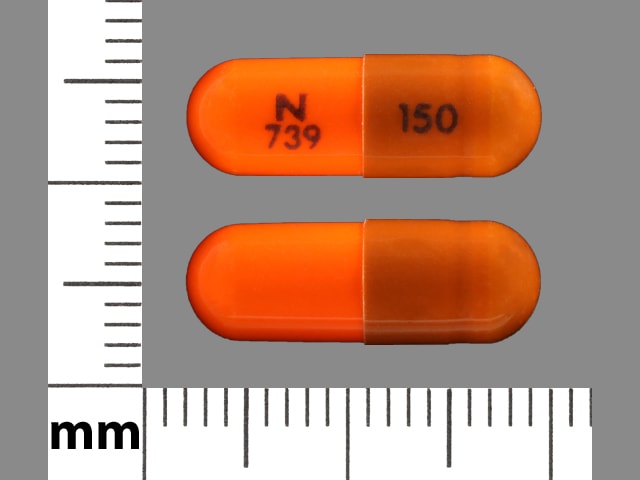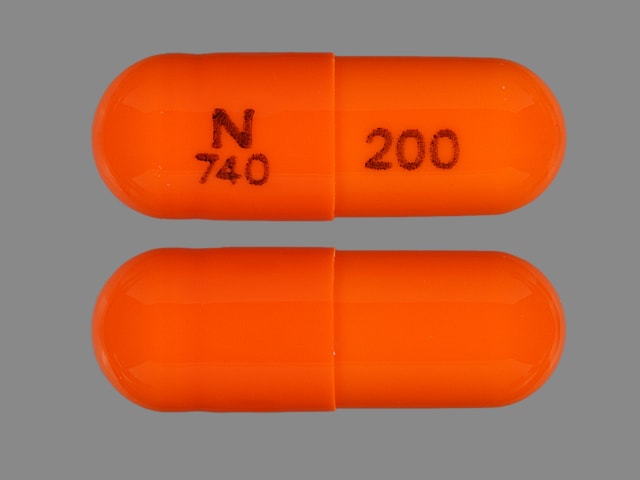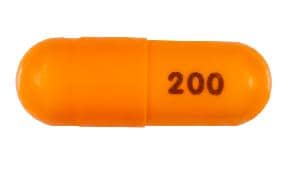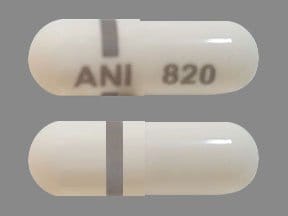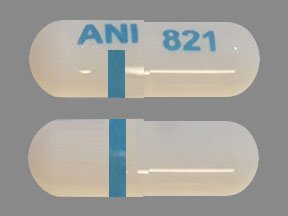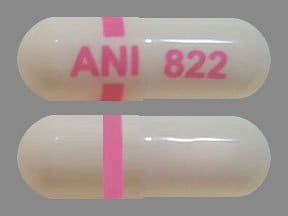Boxed Warning
Mortality:
In the National Heart, Lung, and Blood Institute's Cardiac Arrhythmia Suppression Trial (CAST), a long-term, multicenter, randomized, double-blind study in patients with asymptomatic non–life-threatening ventricular arrhythmias who had an myocardial infarction (MI) more than 6 days but less than 2 years previously, an excessive mortality or nonfatal cardiac arrest rate (7.7%) was seen in patients treated with encainide or flecainide compared with that seen in patients assigned to carefully matched placebo-treated groups (3%). The average duration of treatment with encainide or flecainide in this study was 10 months.
The applicability of the CAST results to other populations (eg, those without recent MI) is uncertain. Considering the known proarrhythmic properties of mexiletine and the lack of evidence of improved survival for any antiarrhythmic drug in patients without life-threatening arrhythmias, the use of mexiletine as well as other antiarrhythmic agents should be reserved for patients with life-threatening ventricular arrhythmias.
Acute liver injury:
In postmarketing experience, abnormal liver function tests have been reported, some in the first few weeks of therapy with mexiletine. Most of these have been observed in the setting of congestive heart failure or ischemia and their relationship to mexiletine has not been established.
Dosage Forms
Excipient information presented when available (limited, particularly for generics); consult specific product labeling.
Capsule, Oral, as hydrochloride:
Generic: 150 mg, 200 mg, 250 mg
Pharmacology
Mechanism of Action
Class IB antiarrhythmic, structurally related to lidocaine, which inhibits inward sodium current, decreases rate of rise of phase 0, increases effective refractory period/action potential duration ratio
Pharmacokinetics/Pharmacodynamics
Absorption
Well absorbed
Distribution
Vd: 5 to7 L/kg
Metabolism
Hepatic via CYP2D6 metabolism to inactive metabolites (~90%) and major metabolites p-hydroxymexiletine, hydroxy-methylmexiletine, and N-hydroxy-mexiletine (minimal antiarrhythmic activity); low first-pass effect
Excretion
Urine (10% as unchanged drug); urinary acidification increases excretion, alkalinization decreases excretion
Onset of Action
30 to 120 minutes (with loading regimen)
Time to Peak
Serum: 2 to 3 hours
Half-Life Elimination
~10 to 12 hours; ~ 15 hours in severe renal impairment (CrCl < 10 ml/min); ~ 25 hours in moderate to severe hepatic impairment
Protein Binding
50% to 60%
Use: Labeled Indications
Ventricular arrhythmias: Management of life-threatening ventricular arrhythmias
Note: The American Heart Association/American College of Cardiology/Heart Rhythm Society (AHA/ACC/HRS) states that mexiletine may be considered for those with long QT syndrome type 3 who present with torsades de pointes (ACC/AHA/HRS [Al-Khatib 2017]; Mazzanti 2016).
Use: Off Label
Amyotrophic lateral sclerosis, painful muscle spasmsc
Data from two randomized, placebo-controlled trials suggest that the use of mexiletine may reduce the intensity and frequency of painful muscle cramps and spasms in patients with amyotrophic lateral sclerosis Oskarsson 2018, Weiss 2016.
Myotonic dystrophy (type 1)c
Data from two randomized, placebo-controlled crossover clinical trials suggest that the use of mexiletine may reduce grip relaxation time in patients with myotonic dystrophy type 1; duration of clinical trial for each lasted 7 weeks Logigian 2010. It is prudent to obtain a cardiology consult prior to beginning therapy. Additional data is necessary to further define the long-term safety of mexiletine in the treatment of this condition.
Ventricular premature beatscyes
Data from two open-label, nonrandomized trials and one open-label randomized trial in patients with frequent premature ventricular complexes (PVCs) suggest that mexiletine may be beneficial for the treatment of this condition. Mexiletine demonstrated suppression of PVCs Rutledge 1985, Saikawa 1992, Tanabe 1991. Use is reserved for when PVCs are symptomatic and conventional therapy has been shown to be ineffective. Additional data may be necessary to further define the role of mexiletine in the treatment of frequent PVCs.
Based on the American Heart Association/American College of Cardiology/Heart Rhythm Society Guidelines for the management of patients with ventricular arrhythmias and the prevention of sudden cardiac death, mexiletine is effective for suppressing ventricular premature beats. Clinical experts recommend beta blockers as first line pharmacologic therapy due to a safer side effect profile Manolis 2018.
Contraindications
Cardiogenic shock; second- or third-degree AV block (except in patients with a functioning artificial pacemaker)
Canadian labeling: Additional contraindications (not in US labeling): Hypersensitivity to mexiletine, amide-type local anesthetics (eg, pramoxine), or any component of the formulation
Dosage and Administration
Dosing: Adult
Amyotrophic lateral sclerosis, painful muscle spasms (off-label use): Initial: 150 mg once daily for 3 days, then increase dose to 150 mg twice daily (Oskarsson 2018). Alternatively, doses up to 450 mg twice daily have been initiated, though higher initial dosing leads to decreased drug tolerability (Weiss 2016).
Myotonic dystrophy (type 1) (off-label use): Oral: 150 mg 3 times daily (Logigian 2010). Note: It is prudent to obtain a cardiology consult prior to beginning therapy.
Ventricular arrhythmias (life-threatening): Oral: Initial: 150 to 200 mg every 8 to 12 hours (may load with 400 mg if necessary); adjust dose as needed in 50 or 100 mg increments no more frequently than every 2 to 3 days up to 300 mg every 8 to 12 hours; usual dose: 150 to 300 mg every 8 to 12 hours (AHA/ACC/HRS [Al-Khatib 2017]); maximum dose: 1.2 g/day.
Ventricular premature beat (symptomatic) suppression (off-label use): Oral: Initial: 100 to 150 mg every 8 to 12 hours; adjust dose as needed in 50 or 100 mg increments no more frequently than every 2 to 3 days up to 300 mg every 8 to 12 hours; usual dose: 150 to 300 mg every 8 to 12 hours (AHA/ACC/HRS [Al-Khatib 2017]; Rutledge 1985; Saikawa 1992; Tanabe 1991); maximum dose: 1.2 g/day.
Conversion:
Switching from other oral antiarrhythmics (eg, disopyramide, quinidine sulfate): Initiate 200 mg dose of mexiletine 6 to 12 hours after the last dose of the former agent.
Switching from IV lidocaine: Initiate 200 mg dose of mexiletine when lidocaine infusion is stopped.
Switching from oral procainamide: Initiate a 200 mg dose of mexiletine 3 to 6 hours after the last dose of procainamide.
Dosing: Geriatric
Refer to adult dosing.
Dosing: Pediatric
Ventricular arrhythmias; life-threatening, including Long QT Syndrome Type 3: Limited data available: Children and Adolescents: Oral: Initial: 6 to 8 mg/kg/day in 2 or 3 divided doses for 2 to 3 days, then increase to 2 to 5 mg/kg/dose every 8 to 12 hours; continue to increase by 1 to 2 mg/kg/dose every 2 to 3 days until desired effect; monitor serum concentrations. Maximum daily dose: 15 mg/kg/day or 1,200 mg/day whichever is less. Based on experience in adult patients, do not exceed the maximum single adult doses of: 400 mg every 8 hours, or 450 mg every 12 hours. In a study of 34 patients (median age: 22 years; IQR: 8 to 44 years) with Long QT syndrome Type 3, a mean dose of 8 ± 0.5 mg/kg/day induced significant shortening of the QTc interval; and 59% of patients exhibited normalization QTC values with mexiletine therapy (Kliegman 2016; Mazzanti 2016; Park 2014).
Extemporaneously Prepared
A 10 mg/mL oral suspension may be with made with capsules and either distilled water or sorbitol USP. Empty the contents of eight 150 mg capsules in a mortar and reduce to a fine powder if necessary. Add small portions of the chosen vehicle and mix to a uniform paste; mix while adding the vehicle in incremental proportions to almost 120 mL; transfer to a graduated cylinder, rinse mortar with vehicle, and add quantity of vehicle sufficient to make 120 mL. Label "shake well". Sorbitol suspension is stable in plastic prescription bottles for 2 weeks at room temperature and 4 weeks refrigerated; distilled water suspension is stable in plastic prescription bottles for 7 weeks at room temperature and 13 weeks refrigerated. Extended storage under refrigeration is recommended to minimize microbial contamination.
Nahata MC, Morosco RS, and Hipple TF, "Stability of Mexiletine in Two Extemporaneous Liquid Formulations Stored Under Refrigeration and at Room Temperature," J Am Pharm Assoc (Wash), 2000, 40(2):257-9.10730027
Administration
Administer around-the-clock rather than 3 times daily to promote less variation in peak and trough serum levels; administer with food or antacid
Storage
Store at 20°C to 25°C (68°F to 77°F).
Mexiletine Images
Drug Interactions
Abiraterone Acetate: May increase the serum concentration of CYP2D6 Substrates (High risk with Inhibitors). Management: Avoid concurrent use of abiraterone with CYP2D6 substrates that have a narrow therapeutic index whenever possible. When concurrent use is not avoidable, monitor patients closely for signs/symptoms of toxicity. Consider therapy modification
Agomelatine: CYP1A2 Inhibitors (Moderate) may increase the serum concentration of Agomelatine. Monitor therapy
Ajmaline: May increase the serum concentration of CYP2D6 Substrates (High risk with Inhibitors). Monitor therapy
Alosetron: CYP1A2 Inhibitors (Moderate) may increase the serum concentration of Alosetron. Management: Avoid concomitant use of alosetron and moderate CYP1A2 inhibitors whenever possible. If combined use is necessary, monitor for increased alosetron effects/toxicities. Consider therapy modification
Antihepaciviral Combination Products: May increase the serum concentration of Mexiletine. Monitor therapy
Asunaprevir: May increase the serum concentration of CYP2D6 Substrates (High risk with Inhibitors). Consider therapy modification
Bendamustine: CYP1A2 Inhibitors (Moderate) may increase the serum concentration of Bendamustine. Management: Consider alternatives to moderate CYP1A2 inhibitors during therapy with bendamustine due to the potential for increased bendamustine plasma concentrations and increased bendamustine toxicity. Consider therapy modification
Broccoli: May decrease the serum concentration of CYP1A2 Substrates (High risk with Inducers). Monitor therapy
Bromazepam: CYP1A2 Inhibitors (Moderate) may increase the serum concentration of Bromazepam. Monitor therapy
Caffeine and Caffeine Containing Products: CYP1A2 Inhibitors (Moderate) may increase the serum concentration of Caffeine and Caffeine Containing Products. Monitor therapy
Cannabis: May decrease the serum concentration of CYP1A2 Substrates (High risk with Inducers). Monitor therapy
CloBAZam: May increase the serum concentration of CYP2D6 Substrates (High risk with Inhibitors). Monitor therapy
ClomiPRAMINE: CYP1A2 Inhibitors (Moderate) may increase the serum concentration of ClomiPRAMINE. Monitor therapy
CloZAPine: CYP1A2 Inhibitors (Moderate) may increase the serum concentration of CloZAPine. Monitor therapy
Cobicistat: May increase the serum concentration of CYP2D6 Substrates (High risk with Inhibitors). Monitor therapy
CYP1A2 Inducers (Moderate): May decrease the serum concentration of Mexiletine. Monitor therapy
CYP1A2 Inhibitors (Strong): May increase the serum concentration of Mexiletine. Monitor therapy
CYP2D6 Inhibitors (Moderate): May decrease the metabolism of CYP2D6 Substrates (High risk with Inhibitors). Monitor therapy
CYP2D6 Inhibitors (Strong): May decrease the metabolism of CYP2D6 Substrates (High risk with Inhibitors). Consider therapy modification
Dacomitinib: May increase the serum concentration of CYP2D6 Substrates (High risk with Inhibitors). Management: Avoid concurrent use of dacomitinib with CYP2D6 subtrates that have a narrow therapeutic index. Consider therapy modification
Darunavir: May increase the serum concentration of CYP2D6 Substrates (High risk with Inhibitors). Monitor therapy
DULoxetine: CYP1A2 Inhibitors (Moderate) may increase the serum concentration of DULoxetine. Monitor therapy
Etravirine: May decrease the serum concentration of Mexiletine. Monitor therapy
Fosphenytoin: May decrease the serum concentration of Mexiletine. Monitor therapy
Heroin: May decrease the absorption of Mexiletine. Monitor therapy
Imatinib: May increase the serum concentration of CYP2D6 Substrates (High risk with Inhibitors). Monitor therapy
Lacosamide: Mexiletine may enhance the adverse/toxic effect of Lacosamide. Specifically the risk for bradycardia, ventricular tachyarrhythmias, or a prolonged PR interval may be increased. Monitor therapy
Lumefantrine: May increase the serum concentration of CYP2D6 Substrates (High risk with Inhibitors). Monitor therapy
Melatonin: CYP1A2 Inhibitors (Moderate) may increase the serum concentration of Melatonin. Monitor therapy
OLANZapine: CYP1A2 Inhibitors (Moderate) may increase the serum concentration of OLANZapine. Monitor therapy
Panobinostat: May increase the serum concentration of CYP2D6 Substrates (High risk with Inhibitors). Monitor therapy
Peginterferon Alfa-2b: May decrease the serum concentration of CYP2D6 Substrates (High risk with Inhibitors). Peginterferon Alfa-2b may increase the serum concentration of CYP2D6 Substrates (High risk with Inhibitors). Monitor therapy
Pentoxifylline: CYP1A2 Inhibitors (Moderate) may increase the serum concentration of Pentoxifylline. Monitor therapy
Perhexiline: CYP2D6 Substrates (High risk with Inhibitors) may increase the serum concentration of Perhexiline. Perhexiline may increase the serum concentration of CYP2D6 Substrates (High risk with Inhibitors). Monitor therapy
Phenytoin: May decrease the serum concentration of Mexiletine. Monitor therapy
Pirfenidone: CYP1A2 Inhibitors (Moderate) may increase the serum concentration of Pirfenidone. Management: Avoid concomitant use of pirfenidone and moderate CYP1A2 inhibitors whenever possible. If combined, decrease the pirfenidone dose to 1,602 mg per day (534 mg three times daily) and monitor for increased pirfenidone toxicities. Consider therapy modification
Pomalidomide: CYP1A2 Inhibitors (Moderate) may increase the serum concentration of Pomalidomide. Monitor therapy
Propranolol: CYP1A2 Inhibitors (Moderate) may increase the serum concentration of Propranolol. Monitor therapy
QuiNINE: May increase the serum concentration of CYP2D6 Substrates (High risk with Inhibitors). Monitor therapy
Ramelteon: CYP1A2 Inhibitors (Moderate) may increase the serum concentration of Ramelteon. Monitor therapy
Ramosetron: CYP1A2 Inhibitors (Moderate) may increase the serum concentration of Ramosetron. Monitor therapy
Rasagiline: CYP1A2 Inhibitors (Moderate) may increase the serum concentration of Rasagiline. Management: Limit rasagiline dose to 0.5 mg once daily in patients taking moderate CYP1A2 inhibitors. Consider therapy modification
ROPINIRole: CYP1A2 Inhibitors (Moderate) may increase the serum concentration of ROPINIRole. Monitor therapy
Ropivacaine: CYP1A2 Inhibitors (Moderate) may increase the serum concentration of Ropivacaine. Monitor therapy
Simeprevir: May increase the serum concentration of Mexiletine. Monitor therapy
Tasimelteon: CYP1A2 Inhibitors (Moderate) may increase the serum concentration of Tasimelteon. Monitor therapy
Theophylline Derivatives: CYP1A2 Inhibitors (Moderate) may increase the serum concentration of Theophylline Derivatives. Management: Consider avoidance of this combination. If coadministration is necessary, monitor for increased theophylline serum concentrations and toxicities when combined. Theophylline dose reductions will likely be required. Exceptions: Dyphylline. Consider therapy modification
TiZANidine: CYP1A2 Inhibitors (Moderate) may increase the serum concentration of TiZANidine. Management: If combined use cannot be avoided, initiate tizanidine in adults at 2 mg and increase in 2 to 4 mg increments based on patient response. Monitor for increased effects of tizanidine, including adverse reactions. Consider therapy modification
Tobacco (Smoked): May decrease the serum concentration of Mexiletine. Monitor therapy
Test Interactions
Abnormal liver function test, positive ANA, thrombocytopenia
Adverse Reactions
>10%:
Cardiovascular: Exacerbation of cardiac arrhythmia (10% to 15%; patients with malignant arrhythmia)
Central nervous system: Dizziness (11% to 25%), ataxia (10% to 20%), nervousness (5% to 10%), unsteady gait
Gastrointestinal: Gastrointestinal distress (41%), nausea (≤40%), vomiting (≤40%)
Neuromuscular & skeletal: Tremor (13%)
1% to 10%:
Cardiovascular: Palpitations (4% to 8%), chest pain (3% to 8%), angina pectoris (2%), ventricular premature contractions (1% to 2%)
Central nervous system: Insomnia (5% to 7%), numbness (fingers or toes: 2% to 4%), depression (2%), paresthesia (2%), confusion, headache
Dermatologic: Skin rash (4%)
Gastrointestinal: Constipation (≤5%), diarrhea (≤5%), xerostomia (3%), abdominal pain (1%)
Neuromuscular & skeletal: Weakness (5%), arthralgia (1%)
Ophthalmic: Blurred vision (5% to 7%), nystagmus (6%)
Otic: Tinnitus (2% to 3%)
Respiratory: Dyspnea (3%)
<1%, postmarketing, and/or case reports: Agranulocytosis, alopecia, amnesia (short-term), atrioventricular block, cardiac conduction disturbance, cardiac failure (patients with pre-existing ventricular dysfunction), cardiogenic shock, decreased libido, diaphoresis, diplopia, dysphagia, edema, esophageal ulcer, exfoliative dermatitis, hallucination, hepatic necrosis, hepatitis, hot flash, hypertension, hypotension, impotence, increased liver enzymes, increased serum transaminases, leukopenia, lupus-like syndrome (drug-induced), malaise, myelofibrosis (patients with pre-existing myeloid abnormalities), pancreatitis (rare), peptic ulcer, pharyngitis, positive ANA titer, psychological disorder, psychosis, pulmonary fibrosis, salivary gland disease, seizure, sinoatrial arrest, Stevens-Johnson syndrome, syncope, thrombocytopenia, torsades de pointes, upper gastrointestinal hemorrhage, urinary hesitancy, urinary retention, urticaria
Warnings/Precautions
Concerns related to adverse effects:
- Blood dyscrasias: Rare marked leukopenia, agranulocytosis, and thrombocytopenia have been reported; often occurs in seriously ill patients receiving other medications that can cause these effects. If significant hematologic changes occur, discontinue therapy (blood counts usually return to normal within a month of discontinuation).
- Drug reactions with eosinophilia and systemic symptoms: Drug reactions with eosinophilia and systemic symptoms (DRESS) has been reported. Discontinue if DRESS is suspected. Symptoms of DRESS include eosinophilia, fever, rash, and/or lymphadenopathy in association with other organ involvement, such as hepatitis, nephritis, hematologic abnormalities, myocarditis, or myositis, sometimes resembling an acute viral infection.
- Hepatotoxicity: [US Boxed Warning]: Abnormal liver function tests have been reported, some in the first few weeks of therapy. Most of these have been observed in the setting of congestive heart failure or ischemia and their relationship to mexiletine has not been established. Marked elevations of AST (>1000 units/L) and rare instances of severe liver injury, including hepatic necrosis, have also been reported. Carefully monitor patients who develop abnormal LFTs or who have signs/symptoms of liver dysfunction. If persistent or worsening elevation of hepatic enzymes occurs, consider discontinuing therapy.
- Proarrhythmic effects: Proarrhythmia may occur with the use of mexiletine especially in those with life-threatening arrhythmias (eg, sustained ventricular tachycardia). Aggravation of arrhythmia may also occur; monitor for proarrhythmic effects (Podrid 1987; Podrid 1999; Velebit 1982).
Disease-related concerns:
- Conduction disturbances: Use with caution in patients with intraventricular conduction delays, first-degree heart block and/or preexisting sinus node dysfunction. Use is contraindicated in patients with second- or third-degree AV block (except in patients with a functioning artificial pacemaker).
- Electrolyte imbalance: Correct electrolyte disturbances, especially hypokalemia or hypomagnesemia, prior to use and throughout therapy (Podrid 1999).
- Heart failure (HF): Use with caution in patients with severe HF; may precipitate or exacerbate condition.
- Hepatic impairment: Use with caution in patients with hepatic impairment; may prolong the elimination half-life of mexiletine and increase the risk of adverse effects.
- Seizure: Use with caution in patients with seizure disorder.
Concurrent drug therapy issues:
- Drug-drug interactions: Potentially significant interactions may exist, requiring dose or frequency adjustment, additional monitoring, and/or selection of alternative therapy. Consult drug interactions database for more detailed information.
Other warnings/precautions:
- Appropriate use: Initiate therapy in the hospital when used to treat life-threatening arrhythmias. Treatment of patients with asymptomatic ventricular premature contractions should be avoided. Has not been shown to enhance survival in patients with ventricular arrhythmias.
- CAST trial: [US Boxed Warning]: In the Cardiac Arrhythmia Suppression Trial (CAST), recent (>6 days but <2 years ago) myocardial infarction patients with asymptomatic, nonlife-threatening ventricular arrhythmias did not benefit and may have been harmed by attempts to suppress the arrhythmia with flecainide or encainide. An increased mortality or nonfatal cardiac arrest rate (7.7%) was seen in the active treatment group compared with patients in the placebo group (3%). The applicability of the CAST results to other populations is unknown. Antiarrhythmic agents should be reserved for patients with life-threatening ventricular arrhythmias. In a double-blind placebo controlled trial in patients with recent MI, the use of mexiletine to reduce premature ventricular contractions demonstrated a numerically greater number of deaths compared to placebo (IMPACT Research Group, 1984).
- Urinary pH: Alterations in urinary pH may change urinary excretion; avoid dietary regimens that may markedly alter urinary pH.
Monitoring Parameters
Liver function tests, ECG
Pregnancy
Pregnancy Risk Factor
C
Pregnancy Considerations
Adverse events have been observed in some animal reproduction studies. A few case reports have demonstrated safe use of mexiletine in pregnant women (Gregg 1988; Lownes 1987; Timmis 1980).
Patient Education
What is this drug used for?
- It is used to treat certain types of abnormal heartbeats.
- This drug may need to be started in a hospital where you will be closely watched. Talk with your doctor.
Frequently reported side effects of this drug
- Anxiety
- Heartburn
- Headache
- Vomiting
- Nausea
Other side effects of this drug: Talk with your doctor right away if you have any of these signs of:
- Liver problems like dark urine, fatigue, lack of appetite, nausea, abdominal pain, light-colored stools, vomiting, or yellow skin.
- Tremors
- Vision changes
- Chest pain
- Severe dizziness
- Passing out
- Shortness of breath
- Excessive weight gain
- Swelling of arms or legs
- Abnormal heartbeat
- Seizures
- Swollen glands
- Unable to pass urine
- Change in amount of urine passed
- Bruising
- Bleeding
- Severe loss of strength and energy
- Muscle pain
- Muscle weakness
- Change in balance
- Signs of a significant reaction like wheezing; chest tightness; fever; itching; bad cough; blue skin color; seizures; or swelling of face, lips, tongue, or throat.
Note: This is not a comprehensive list of all side effects. Talk to your doctor if you have questions.
Consumer Information Use and Disclaimer: This information should not be used to decide whether or not to take this medicine or any other medicine. Only the healthcare provider has the knowledge and training to decide which medicines are right for a specific patient. This information does not endorse any medicine as safe, effective, or approved for treating any patient or health condition. This is only a brief summary of general information about this medicine. It does NOT include all information about the possible uses, directions, warnings, precautions, interactions, adverse effects, or risks that may apply to this medicine. This information is not specific medical advice and does not replace information you receive from the healthcare provider. You must talk with the healthcare provider for complete information about the risks and benefits of using this medicine.
